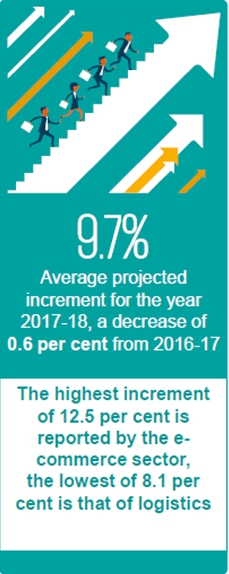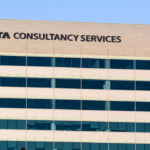The average salary increase across sectors is expected to be 9.7 per cent in this fiscal, 6 points less than the actual figure of last fiscal.
The annual compensation & benefits survey by KPMG suggests that this fiscal (2017–18), the average increments will be around 9.7 per cent. This implies a fall of 0.6 per cent vis-à-vis the actual increments received by employees across sectors in the last fiscal.
To add to that the variable pay is also expected to increase from an average of 15 per cent to 15.4 per cent.
The KPMG study is based on inputs from 263 companies across 19 sectors. More than 50 per cent of the companies surveyed have a turnover of Rs 1000 crore plus.
Employees in BFSI and IT will see a maximum drop in increments—1 and 0.9 percentage points, respectively.
Though there has been a fall in increments across sectors, employees in the pharma, retail and energy sectors can heave a sigh of relief as the drop is minimum and the increments are higher vis-à-vis other sectors.
Pharma is expected to offer the highest increment of 11.4 per cent followed by retail at 11.1 per cent. Next is A&M (advertising and media) at 10.6 per cent and consumer goods at 10.3 per cent.
The salaries are expected to grow at a slower rate in IT (9.8 per cent). However, in the ITES sector, the growth will be comparatively better at 10.1 per cent.
Almost 91.9 per cent of the respondents of the survey acknowledge that they have a variable pay component. The most prevalent programme is Individual Performance Awards, commonly given to individual contributor cadres in the middle management.
The variable pay component across sectors is expected to increase by 0.4 percentage points on an average. However, the variable pay components continue to be highest in the BFSI sector, with an average of 19.9 per cent, which is 0.3 points more than the previous fiscal. Pharma, which is expected to offer a maximum increase in salary, will also see an increase in variable pay by 0.3 points to 17.4 per cent.
Among different levels of employees, the worst affected will be the senior management. For this segment, the average increments are expected to fall by 0.6 points vis-à-vis last fiscal, while for top management the drop will be 0.4 points.

The biggest beneficiaries of this fiscal’s increments will be the junior management with an average increase of 10.4 per cent followed by individual contributors at 10.3 per cent and middle management at 9.9 per cent.
As obvious, the variable pay component increases as one moves up the hierarchy ladder. For instance, the average variable pay for top management is expected to be around 23.6 per cent.
The study reveals that there is also a sense of uncertainty in the job market. Around 37 per cent of the respondents found this subject to be a critical one.
On one hand, robotics and cognitive automation promises to release bandwidth for higher value-adding work, leading to reduced errors and cost reduction. However, automation of business processes that are repetitive, rule-based, and voluminous are expected to impact ‘middle-income routine jobs’, that are likely to be replaced by cognitive platforms and smart algorithms.
Cognitive technology is envisaged to enhance skills and expertise, unlocking the true value of human capital, despite projected scenarios of massive unemployment.
For the respondents—around 48 per cent of them—another critical subject was digitisation of HR. Digital is poised to disrupt HR and redefine the future of the HR function. More and more organisations are looking to transform their HR services through the use of technology-enabled digital platforms, mobile applications and integrated HR systems.
Increasing number of organisations are planning to evolve from the traditional HR operating model, developing strategy and vision for the HR target operating model. This will integrate digital solutions and achieve higher efficiency and effectiveness, and also increase the value-add of the HR organisation.
Value our content... contribute towards our growth. Even a small contribution a month would be of great help for us.
Since eight years, we have been serving the industry through daily news and stories. Our content is free for all and we plan to keep it that way.
Support HRKatha. Pay Here (All it takes is a minute)




































